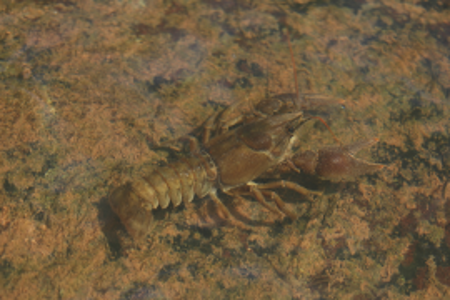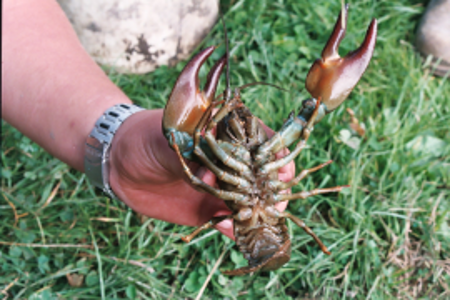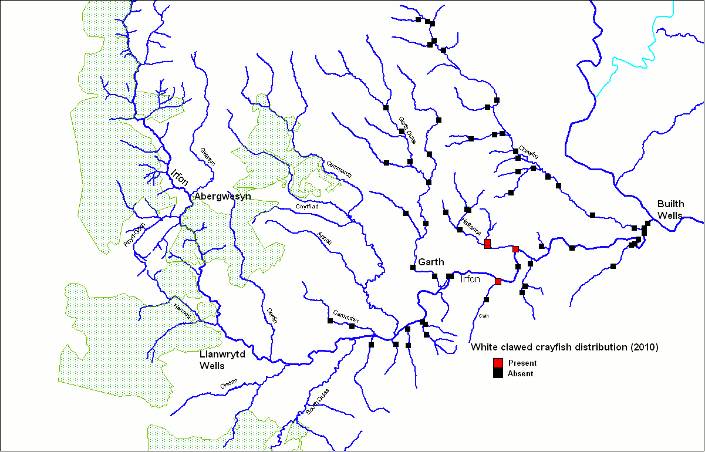White clawed crayfish Austropotamobius pallipes.


The White-clawed crayfish (Austropotamobius pallipes) lives in a variety of clean aquatic habitats but especially favours hard-water streams and rivers. A major threat to this indigenous species is posed by the introduction of non-native species of crayfish, which have been farmed in Britain since the late 1970s. Soon after this, crayfish plague (a virulent disease caused by the fungus Aphanomyces astaci) broke out and spread rapidly, causing drastic losses of native crayfish in rivers in England. This disease was introduced and is spread by the most frequently farmed species, the North American signal crayfish (Pacifastacus leniusculus). Crayfish plague can be introduced into a waterbody not only by entry of signal crayfish but also by water, fish or equipment that has been in contact with them. This greatly increases the risk to remaining white clawed crayfish populations.
Signal and other non-native crayfish are larger and more aggressive than the native species and are able to produce more young. Consequently, the introduced species also pose a threat through predation and competition. In Britain, signal crayfish are now well-established in the wild. In Northern Ireland no crayfish farms have been established and crayfish plague is unknown, although it occurs in the Republic of Ireland (Holdich & Reeve 1991; Holdich & Rogers 1997). It is only in areas free of disease that white clawed crayfish are likely to survive in the future.
A significant part of the EU's white claw population is found in the UK and the Republic of Ireland, where it is widespread. It was found in most parts of England and used to be common in parts of eastern Wales. It is present in south-west Northern Ireland. The species is now seriously threatened over most of its range in Britain.
White clawed crayfish in the Irfon
Within the Wye and especially the Irfon there was a major retraction in distribution and numbers between 1970 and 2010. In the absence of signal crayfish it is likely that the increasing use of insecticides as the sheep flock increased, in particular the use of highly toxic synthetic pyrethroid (SP) sheep dips in the late 1990s and early 2000s that caused this. In common with most remaining populations in the UK and Europe, extinction seems likely unless serious conservation efforts are

directed towards this species and its habitat now. Whilst the SP dips have been withdrawn from use in livestock farming, their use in forestry and arable farming continues.
The species is an important indicator of a river's health. Those white claws that survive toxic sheep dips are threatened with elimination from signal crayfish plague and habitat degradation. The principle for the rejuvenation of salmon, pearl mussels and white claws remains the same: we need to remove the adverse conditions, particularly water pollutants and restore good habitats. Much of what is good for one species is good for all.
ISAC Objectives:
At the start of the project in 2010 the white clawed crayfish was failing to meet its conservation objectives within the Wye SAC and only a few localised populations remained, making the species highly vulnerable within the SAC. Re-introduction to appropriately managed sub-catchments within the Irfon and Wye SAC within its traditional home range and in areas at low risk of plague and sheep dip was acknowledged as a viable option towards its restoration.
The survey in 2010 confirmed the contraction in range and established that stocks were too low to support the original plan which had been to translocate substantial numbers of individuals to establish new populations. Following the success of a captive breeding programme in 2010 at the Abercynrig hatchery, pioneered by the Environment Agency Wales in conjunction with Bristol Zoo, white claws have been taken from threatened populations in South Wales and Herefordshire to be used to generate in excess of 1,000 juvenile crayfish a year and to create at least two new populations in the catchment. Appropriate habitat will also be restored and preserved.
For details of the work carried out within the project, please click here.
